The original question was: How do you measure d in the equation for universal gravitation ()? It can’t be the distance between the surfaces of the objects, or when they touched f would be “infinite.” It can’t be the distance between their centers of masses because if I shot a bullet into a rubber ball their centers of mass might coincide, and again d would be zero. It can’t be the distance between the center of mass of one object and the surface of the other object, because there would be two possible d’s.
Physicist: Nature abhors a singularity. So when you see a nice glaring one (like this case, where d=0 makes the force jump to infinity) it’s worth pausing to consider how the universe finagles its way out. When you apply Newton’s Law of Universal Gravitation, , to planets and stars, d is indeed the distance between the centers of mass. But when to use that standard and why it works is a little subtle.
One of the most important ideas in physics is that the exact same laws apply to everything, everywhere, always. Nothing and nowhere gets special treatment, and that includes the center of mass.
The stuff at the center of the Earth does pull on you, but that’s nothing special; so does literally everything else. Phone books, your worst enemy, that thing you saw that one time, everything on Earth (and otherwise) pulls on you according to Newton’s law. Every atom pulls on every other atom.
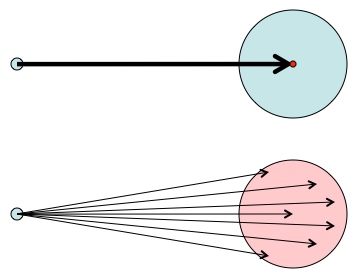
All mass creates gravity and pulls things toward it. Here on Earth, we always feel a pull toward the center of the Earth (top), so it might seem as though there’s something special down there. In reality, we’re experiencing the collective pull of everything in and on the Earth (bottom).
The reason you don’t notice a pull toward each individual thing around you is that gravity is weak. The physical (as opposed to emotional) attraction between you and someone you’re walking next to is a force on the order of the weight of a mote of dust (tens of nanograms). The air moving in and out of your lungs pushes you around far, far more.
The reason you do notice a pull toward the Earth is that there’s a lot of Earth to do the pulling; around 100,000,000,000,000,000,000,000 times the mass of the person next to you. Sure it’s farther away (around 4,000 miles on average), but there’s a lot of it. Heck, it blocks half the sky (the lower half).
Finally, the reason everyone feels a pull toward the center of the Earth is that, for most intents and purposes, the Earth is a perfect sphere. No matter where you are and no matter how you look at it, you can draw a line through the middle of the Earth and the two sides will be mirror opposites of each other. As much as one half pulls you to the right, the other pulls you to the left. The collective pull of both halves is right down the middle; toward the line between them.
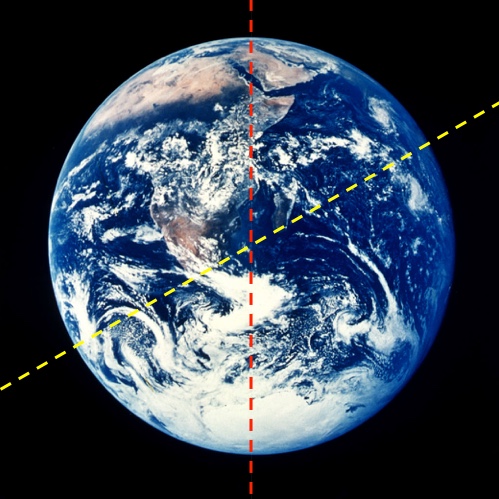
The matter on the left side of the (red) line pulls you down and to the left, the matter on the right pulls you down and to the right. Because the two sides are essentially the same, the “left-and-right-ness” cancel out, leaving a net down. For a sphere, you can repeat the same argument for any (yellow) line through the center.
The same argument applies to any line that separates the two halves, and all of those lines pass through the center of mass. Technically, that’s how the center of mass is defined. So, because the mass of the Earth is spherically symmetric, gravity around here points toward the center of mass.
However! Gravity does not, in general, point toward the center of mass. Take for example the Earth-Moon system. Despite its non-contiguous-ness, it’s still a perfectly legit collection of mass. The center of mass of the Earth and Moon combined is a point just a little below the Earth’s surface. That fact is important when you consider how the two orbit each other (the Moon circles that point while the Earth kinda wobbles around it), but it is almost entirely unimportant when you consider how gravity pulls on things presently sitting on Earth’s surface.
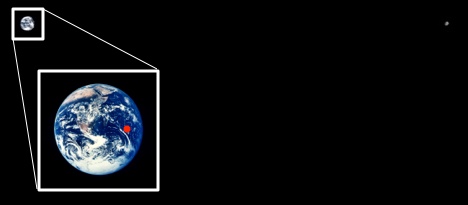
The Earth-Moon system to scale. Notice that gravity does not pull you toward this system’s center of mass (the red dot) it pulls you toward the largest nearby thing (the pale blue dot).
That all said, Earth is only almost perfectly spherical. You may have noticed that the world is not a perfectly polished ball; there are mountains, oceans, gigatons of missing single socks, and that non-uniformity penetrates well below the surface. Those variations in the distribution and density of mass means that Earth’s gravity changes (very, very slightly) from place to place, both in magnitude and direction.
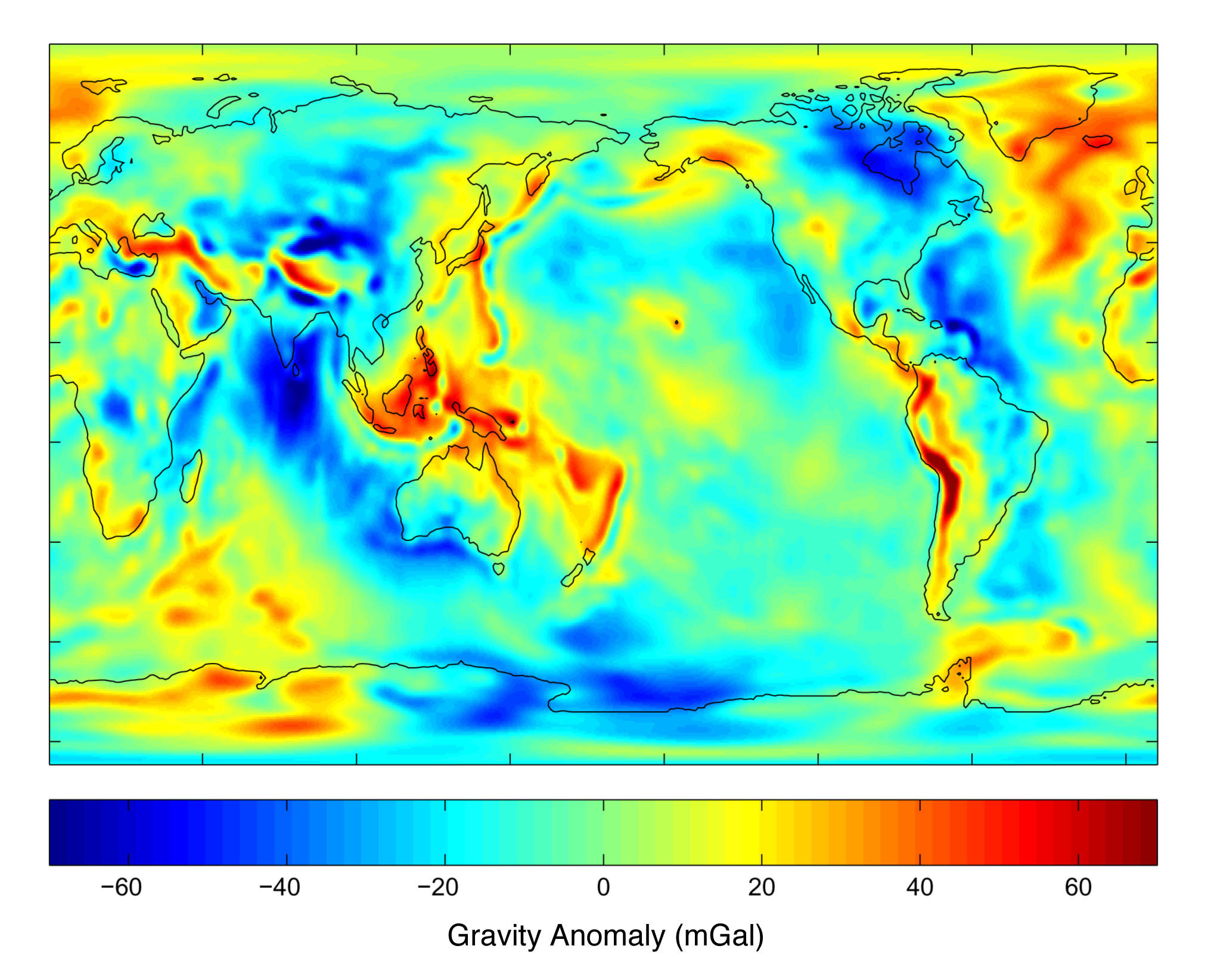
Deviations in the strength of Earth’s gravity. The average surface gravity of Earth is around 980 Gal (1 Gal = 1 cm/s2). Surface gravity points away from Earth’s center the farthest where the colors are changing the fastest.
By flying a pair of satellites in formation over the Earth and measuring the distance between them we can detect them speeding up and slowing down with respect to each other as one, then the other, passes over differently-gravity’d regions.
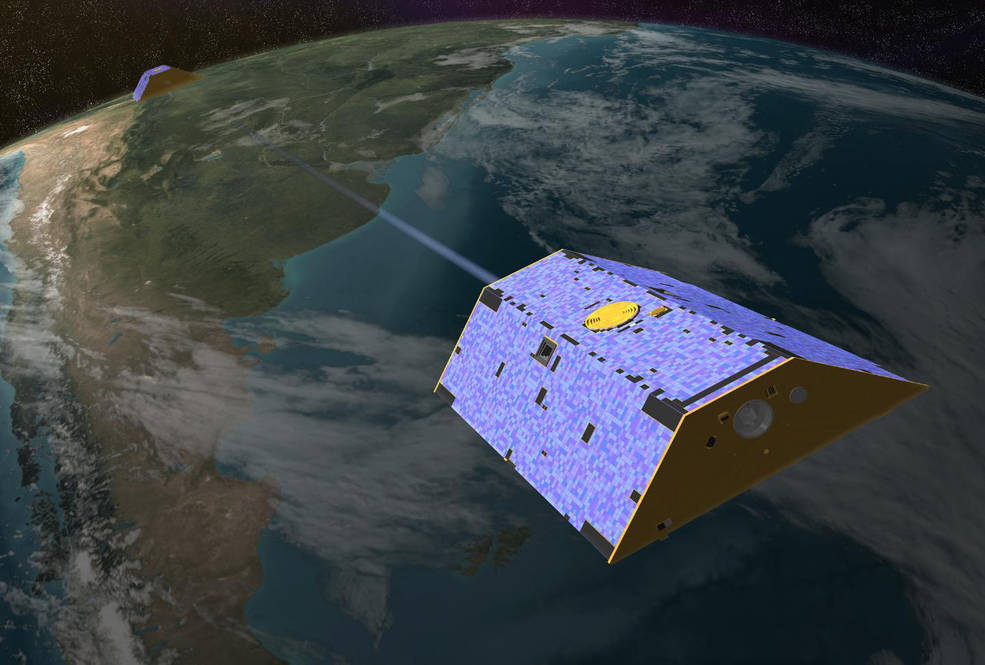
The GRACE (Gravity Recovery And Climate Experiment) satellites, cleverly called “GRACE-1” and “GRACE-2”, shot lasers at each other from 2002 to 2017 to measure Earth’s gravity field over that time. They were so stupefyingly sensitive that they could detect changes in the location of water and ice through the gravity they generate (hence the “climate” part).
Finally, to more directly address the original question, since gravity is a collective pull toward each individual piece of mass and not necessarily a pull toward the center of mass, Newton’s universal law of gravitation has to be applied with a little finesse. works fine (with d the distance to the center) as long as you’re outside of a sphere of mass, it stops working as soon as you’re inside because the mass above you counteracts the pull of the mass below you. In the case of a bullet shot through a rubber ball, this is why the gravitational force never jumps to infinity; the equation that says it should ceases to apply. The universe always has an obnoxious way to get out of having to deal with singularities.
Because gravity is an “inverse square force” (the “” in “
” ) it has the remarkable property that the total gravitational field pointing into any closed “bubble” is proportional to the amount of mass contained within that bubble. Inverse square laws also describe the way light gets dimmer with distance: so if you build a glass bubble around a light source, no matter how big or what shape the bubble is, the same total amount of light flows out of it.
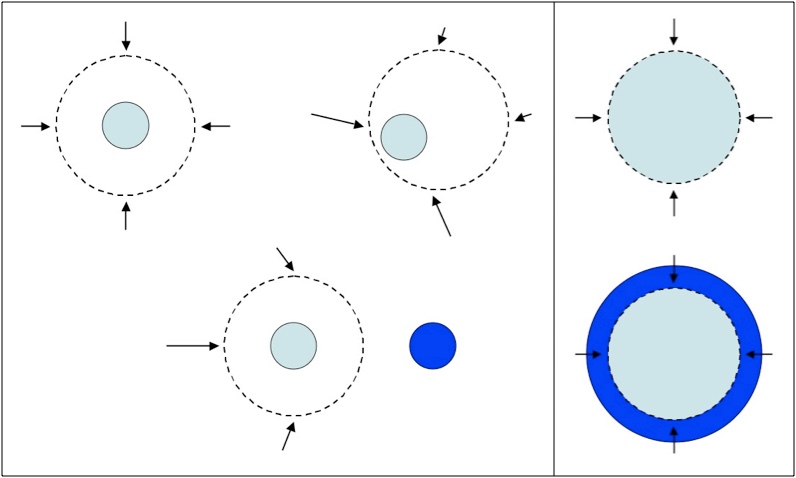
Left: The force through any particular part of the bubble can change, but the total depends only on the amount of mass inside. Right: If the mass is distributed spherically, then the force is the same everywhere on a spherical bubble (what would make it different?) and we can see why the outer layers of a planet have no impact on the gravity inside of a planet.
The beauty of this is that it allows us to do what should be an arduous calculation (adding up the contribution from every tiny chunk of matter) in a manner that appeals to physicists: stupid easy and deceptively impressive. One of the immediate conclusions of this is that, as long as you’re outside of the sphere of mass in question, there’s no difference between the gravity of a sphere of mass and the same amount of mass concentrated at a point. So if the Sun collapsed into a black hole, everything in the solar system would continue to orbit it as though nothing had happened, because the gravity would only have changed below where the surface of the Sun used to be.
The second cute conclusion of this is that if you’re inside of a sphere of mass, only the layers below you count toward the gravity you feel. So the closer you are to the center, the less mass is below you, and the less gravity there is. If you were in an elevator that passed through the Earth, you’d know you were near the center because there’d be no gravity. With the same amount of mass in every direction, every atom in your body would be pulled in every direction equally, and so not at all. A sort of gravitational tug of war stalemate.
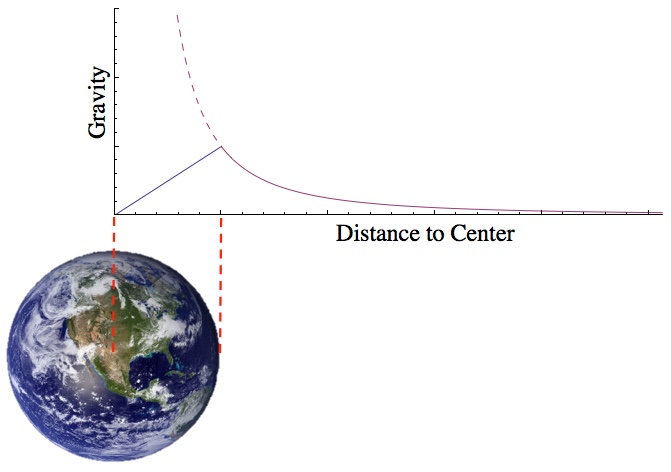
As you approach a sphere of mass gravity increases by the inverse square law, but drops linearly inside the sphere. If the density varies (which it usually does), that straight line will bow up a bit.
Newton’s Universal Law of Gravitation applies to everything (hence the “universal”). But instead of applying to the centers of mass of pairs of big objects, it applies to every possible pair of pieces of matter. In the all-to-common-in-space case of spheres, we can pretend that entire planets and stars are points of mass and apply Newton’s laws to those points, but only as long as we don’t need perfection (which is usually). As soon as things start knocking into each other, or the subtle effects of their not-sphere-ness become important, you’re back to carefully tallying up the contribution from every chunk of mass.
The pedestal with nothing on it used to have a guy stabbing a bird. The picture is from here.
The GRACE stuff is from NASA.








Would agree with everything except the phrase nature abhors a singularity. Its the maths modern physics is based on that cant tolerate singularities – or other types of infinity.
There is an old theory called Newtonian singularities where every massed object is in effect a micro singularity dependent on d = 0.
The math for this theory doesn’t fit with the normal speed of light because the Schwarzschild radius required is far too small. (for a proton 2.5E-54 m) However if the objects local speed of light is set near to zero then the maths does work. (Going into how that might be possible gets a lot more involved and is an area beyond the edge of current physics.)
The simple answer is: by the definition of Centre of mass. Center of mass is a point towards which the gravity pulls. If a body of non-zero size is situated in a gravitational field, every point of the body is pulled accordingly to the field at that point. Summurazing (integrating) forces acting on every point leads to a single force applied in the Center of mass.
@Leonid Gerzon
Sometimes that’s nearly true, but not in general. For example, if that were always the case, then gravitational interactions would be incapable of applying torque, but we see that all the time.
Pingback: Q: Could the “proton torpedoes” in Star Wars be a thing? | Ask a Mathematician / Ask a Physicist
Daily life disproves Newton and his “gravity”. Why is this not acknowledged?
The International Space Station exhibits zero-gravity regardless and yet its mass or laughably proclaimed gravity bubble has zero-attraction to spacewalkers, though the math says they should stick to the outside with at least 1-pound of force.
Much more extreme and undeniable examples from Stadiums to Skyscrapers to grand old stone Churches (that disproved Newton himself) to Mountains and especially Cliffs mathematically require that an average person must be sucked to the side of their bases.
Can you please cite a demonstration ( I haven’t found even one) that gravity’s direction of force is only and ever to the center of mass and never-ever relative?
Iggy, let’s calculate the force between International Space Station and an astronaut who is standing on its surface.
Mass of the station is about 500 kg, mass of an astronaut is 70 kg.
The width of the station is around 2m, so the distance of the astronaut from the station center of mass is 1 m.
F = 6.7*10^(-11) * 500 * 70 / (1^2) = 0.000002345 Nt.
Tiny force that cannot be noticed.
Even if the whole of the space station could be pressed into a small ball size of 1mm and the astronaut could be pressed to be ball of same size and they would touch one another, the force would be:
F = 6.7*10^(-11) * 500 * 70 / ((2 * 10^(-3))^2) = 0.59 Nt – still very small force.
Reading this again I noticed a tiny error.. The mass of the ISS is about 420,000 Kg not 500..
In regards to center of mass there is nothing special about it at all. In reality it is just the point of the axis where an objects natural center of rotation exists.. It offers a neat mathematical shorthand for treating an object as a simple single entity of mass rather than a volume of matter.
If you need more detail (say for one object in a close orbit around another) more detailed volumetric methods are obviously available. This becomes essential for calculating things like tides, tidal lock, frame dragging, and so on.
Thank you for trying Leo, but your figures are very grossly inaccurate. Your ISS figure should’ve been 500,000-kg to be anything close to its actual 462-tons…see bottom of https://www.nasa.gov/feature/facts-and-figures
And, your Astronaut figure did not at all account for the 145-kg Environmental Suit…see Enhanced EMU of https://en.wikipedia.org/wiki/Extravehicular_Mobility_Unit
I was being timid with my very generalized statements…the ISS is a pebble compared to a Skyscraper, the Pyramids or some old Cathedral. I’ve double checked my math with this calculator https://www.ajdesigner.com/phpgravity/newtons_law_gravity_equation_force.php#ajscroll which you may also find useful and very revealing.
Gravity is allegedly the culmination of each atom’s individual gravity and yet even astronomy has failed to find any multiplication of gravity anywhere, though it baselessly claims how everything finally came to be as it is today. Even our solar alignments have resulted in an absolute zero effect on our tides, which is quite a contradiction.
Sorry guys for my 1000-fold error, if we fix it and also double the astronaut’s mass, the gravitational force between the station and the astronaut will come to 0.004 Nt which is still very very tiny force and cannot be noticed.
Sorry Leo, that’s still extremely wrong. But, thank you for continuing to insist that I’m a moron who did no research. Under the current model we’re about 4,000-miles from Earth’s focus of gravity or almost out of Earth’s gravity…it’s very weak.
My point is, that gravity does not, at all, match the theory, math nor reality. And yet, no-one questions the fake “science” ignorantly presented by any of these ancient buffoons…I won’t even get into the new imbeciles.
@Iggy (where G is the gravitational constant, M and m are the two masses in question, and r is the distance between them), you should be able to confirm that yourself. For non-spheres you have to be careful (“careful” = “do a volumetric integral”), but as long as r is more than the distance to the near side and less than the distance to the far side, it’s in the right ballpark. So Leo’s calculation (initial error notwithstanding) is worth considering.
(where G is the gravitational constant, M and m are the two masses in question, and r is the distance between them), you should be able to confirm that yourself. For non-spheres you have to be careful (“careful” = “do a volumetric integral”), but as long as r is more than the distance to the near side and less than the distance to the far side, it’s in the right ballpark. So Leo’s calculation (initial error notwithstanding) is worth considering.
In the case of spheres (like Earth), gravity points toward the center of mass, but for more complicated shapes that isn’t generally true. That’s what this post is all about.
When you stand next to a building, the mass of that building does pull on you more than the same amount of mass on the far side of the planet, but neither building holds a candle to the mass of the Earth and the force it produces. Using Newton’s universal law of gravitation,
Where did you learn that the space station pulls on astronauts so hard? Or can you provide the derivation you used?
Hi Physicist. I get you, my understanding is that there’s always a gravity bubble and it would simply flatten out to a rather thin oval in the case of the ISS. Is that not correct?
I’ve taken a regular bathroom spring scale to a mile tall mountain range and found no difference in my weight through all of my checkpoints from sea-level to mountain summit. Though, the math says something very different. That’s very uncharacteristic of gravity, is it not?
Hence, why I asked how there is no sign of gravity with ISS spacewalkers…whom have removed Earth’s possible interference from our, technically, artificial gravity. My variable was a distance of 1-inch/25mm, which actually comes out to about 2-pounds/.95kg of gravitational force…using the figures I linked.
Shouldn’t NASA and science as a whole be instantly “concerned” that there has never been a re-establishment of gravity ever found with the 3 space stations of history? I am and always have been, but no-one cares to question “science”.
@Iggy
Measuring your weight at different altitudes is a great experiment! That’s exactly how science is done. What you’ve empirically discovered is that either there is no difference in your weight or the difference is imperceptibly small.
Using Newton’s law of gravitation, over a mile the difference in gravitational acceleration (which is what dictates you weight) drops by a little over one part in 2,000. For a person, that’s a difference in weight on the order of a tenth of a pound (which is larger than I would have thought).
If you live near that mountain, try the experiment again with a digital scale and something with a fixed weight (a steel brick or something). Something that weighs a few kg at the bottom of the mountain should weigh a few grams less a mile up.
What’s a “gravity bubble”?
Hey Physicist. I do plan on solidly proving or disproving gravity with more sensitive equipment. But so far, I’ve only been able to disprove it. Unfortunately, I’ve measured no weight change inside 2 skyscraper basements, 3 mountain tunnels and 2 old stone churches…hoping to use the spring scale as a diviner in order to find the actual center of gravity, since the math says 1-pound or more should exist (reverse gravity in the tunnels).
However, the ISS situation is still excessively troubling. Since, it’s hollow there’d have to be a definitive center of gravity where any and all items would be drawn to and literally get stuck in. A gravity bubble is akin to a magnetic field, but it attracts anything. Only lighter-than-air items might defeat it.
Thus, why NASA’s criminal fakery is so apparent to me. IF, they were anything they claim to be, they would have engineered minor gravity into the ISS to have a floor…either of 2 simple designs would’ve accomplished this. For people and their astonishingly laughable “experiments” Zero-G would still exist 3-feet and farther from the floor.
@Iggy . Using that law, you will find that near the surface of the Earth the strength of gravity varies by about 1 part in 2000 every mile.
. Using that law, you will find that near the surface of the Earth the strength of gravity varies by about 1 part in 2000 every mile.
The math we use to describe the strength of gravity is Newton’s Universal Law of Gravitation,
Using the same equation, you will find that the gravity from individual buildings and even mountains is undetectable without really sensitive equipment. Spring scales unfortunately don’t come close.
The idea you mention, that gravity always points toward the center of mass, is what the post above is all about. Hollow space stations, buildings, or whatever else definitely do not have some special location where gravity concentrates. Matter is what generates gravity, so it’s the walls of the space station that generate the ISS’s minuscule gravity (because that’s where most of the mass is). If you were inside and happened to pass through the center of mass, you’d never notice (because it’s nothing special).
The closest that NASA (or anyone else) can get to generating gravity on-demand is centripetal force. Which is to say, spin the ISS and everything inside would be flung outward. They don’t do that because there are a lot of engineering issues. The whole thing is very delicate.
#The Physicist
Not sure you can explain this in a way he will understand. Describing gravity was a frame defined force doesn’t help, talking about shortest world lines and curved space time is even worse. Maybe he should try playing KSP for a while, it certainly gave me a much better grasp of the physics of things like gravity.
Gravity engines are something I had taken an interest in before and they are truly one of the most impossible things in physics. – The G constant 6 x 10^-11 combines with E = mc^2 to create an almost insurmountable barrier. A starting point might be mastering the use of micro singularities and if you can get something with negative mass..
The LIGO experiment though has proved that gravity waves exist – which means that things like gravity engines could (maybe) work without violating the conservation of mass.
@The Physicist
Sorry but, I can’t agree. Based on the calculator I linked above, which you may find a problem with though I haven’t, even a 1-pound item (weighed on Earth’s surface) on the ISS would have an almost 3-pound gravitational force at 1-mm away from the center of mass/gravity, which of course the ISS must have and can’t not have.
That above, is why I expected some much larger, than you’re talking about, fluctuations in my basic experiments. Therefore, if gravity is nothing but the collection of individual matter/atoms’ gravity. Then, shouldn’t gravity be relative to my masses position? Similar to how the Moon is to Earth’s center of gravity/mass…allegedly, though no-one feels any such mandatorily truly massive change in gravity.
Meaning, mustn’t there be a substantial difference on top of a Mountain than at the bottom of the Grand Canyon or in Denver compared to Atlantic City or weigh less in an Airplane altogether (nothing does and quite the contradiction to your statement that follows)? I realize you said proximity to the center of mass matters slightly more than additional mass. NASA showed zero-g at just 90-miles up with the Gemini missions.
If I can gratefully continue to bother you just a little longer. How is gravity defeated entirely for an extended period of time with something like the Vomit Comet? I can understand gravity losing grip only momentarily like some Roadrunner Cartoon, but by definition isn’t gravity required to take back control immediately? Jumping off a bridge into a stream or riding a carnival amusement or elevator isn’t falling faster than gravity’s force nor atmospheric pressure.
@Iggy
The post above is about avoiding the (very common) mistake you’ve made here. Newton’s Law (which you linked to) may say that if all of your mass is a mm away from all of the mass of the ISS there will be a pound of force, but that isn’t something that ever happens. There is no way to be within a mm of all of the mass in the ISS because the ISS is bigger than a mm across.
To accurately apply Newton’s Law you’d need to apply it between every part of the astronaut’s body and every part of the ISS and then add all of those results up. The “center of mass” thing works in two cases: 1) when one of the objects involved is a sphere and 2) when the two objects are so far apart that they look like points to one another.
The strength of gravity is certainly dependent on your position, but you typically need huge objects and huge distances. Masses on the scale of buildings and distances on the scale of miles are far too small for people or not-extremely-sensitive equipment to notice. You can detect the difference between Denver and the Grand Canyon, but not with a bathroom scale.
Things in orbit (like the Gemini missions) aren’t in zero gravity, they’re in orbit. To be in orbit it’s not enough to be 90 miles up, you need to be 90 miles up and moving sideways at around 8 km/s. There’s an old post here that talks about that (in the context of falling to Earth).
The Vomit Comet (I love that name) doesn’t “defeat gravity”, it follows a “parabolic path” like a thrown stone. If you were in a free-falling elevator you’d float around the room (you can feel this a little near the top of an elevator trip). The plane and everything in it are in free-fall. When you toss a stone up in the air over and over it’s weightless as it falls through the air and extra heavy when it’s landing in your hand and being thrown again. Similarly, people in the Vomit Comet experience extra weight near the bottom of each flight. If you find a long enough video of any Vomit Comet flight you’ll see everyone rush to get to the floor before the plane gets to the bottom of a “hop”. This video talks a bit more about how they work.
@ The Physicist
I think you misunderstood. At first, I was talking about a spacewalker and the math doesn’t really work out for my variable…depending where the spacewalker is…I was asking if gravity would be relative and that slice of the ISS would only apply to the spacewalker.
But, my last model was more so thinking of a wrench, bolt, water packet etc. So yes, 1-mm to the center of mass that must be floating within the ISS and collecting dust, hair, VOC’s and other gases would actually be unavoidable…if NASA weren’t such a big fat fraud.
Actually, the math says 1-pound more/less for the 2-mile difference of Denver and the Grand Canyon for the distance change…without adding/subtracting the billion+ tons of mass, just an FYI.
You are correct about orbiting, my mistake. NASA’s fraud of only 17,200-mph for being a little more than half as high as the ISS probably threw me off. However, I still don’t get how gravity can be tricked for quite long periods, specifically when there’s no air resistance.
Simply spinning things to create artificial gravity doesn’t work, as real zero-g equalizes across everything in just seconds. Centrifugal and Centripetal forces are a complete hoax for zero-g…very easy to prove by spinning a thread in a cup of water or looking at an ISS video that cuts out before the truth fully reveals itself.
Two debunkers of gravity are World Record Skydivers, they drop a bit more than twice as fast as gravity’s “constant”, until they encounter heavier atmosphere. The other is the Cavendish Experiment, which never exhibits any such acceleration to ever be equated nor related to gravity.
Pingback: Q: Do we actually live in a computer simulation? | Ask a Mathematician / Ask a Physicist
hmm
Astronauts on the ISS are always in free fall; they get used to the feeling after a while. They’re are 1) moving forward and 2) falling in the direction of earth’s center of mass. The mass of the ISS does slightly impact the astronaut’s motion. So, if you want to be very precise, that needs to be included. This is why astronauts appear to be ‘floating’ inside the ISS. This ‘floating’ is similar to what’s experienced by anyone on ‘zero-gravity’ parabolic flights in earth’s atmosphere.
Gravity = Acceleration?
Does the Earth PULL the APPLE to the ground or
Does the Sky PUSH the APPLE to the ground?
Which is correct: GRAVITY is pulling matter together or ANTI GRAVITY, another name for DARK ENERGY, is pushing it together?
Which is correct: GRAVITY, is inside MATTER somewhere, or ANTI GRAVITY is outside everywhere in empty SPACE?
DARK ENERGY in physics is defined as a repulsive force that counteracts gravity and causes the universe to expand everywhere at an accelerating rate. My suggestion is that DARK ENERGY is ANTI GRAVITY.
Most likely it is ZERO POINT ENERGY, The COSMOLOGICAL CONSTANT and VIRTUAL PARTICLES too.
My next suggestion is that THERE IS NO GRAVITY!
My idea is similar to a universe wide CASIMIR EFFECT on all matter. Here, instead of two metal plates being pushed together, there are “plates” of matter and the expanding space around them, pushing them together.
Dr Einstein said his breakthrough came when he imagined an analogy of an elevator in space. As acceleration increases, gravity increases. The person in the elevator can’t tell if he is in an elevator traveling in space or one on Earth.
BUT WHAT IF WE ARE BOTH RIGHT.
Look at the drawing.
There are two round elevators.
The elevator on the left IS NOT accelerating.
No acceleration = No gravity
The force of empty space or anti gravity, pushes on all sides equally.
The elevator on the right IS accelerating.
Acceleration = Gravity.
The force of empty space or anti gravity, pushes on all sides, but mostly from the front due to acceleration! The acceleration scrunches up the forces in front. They overlap each other from the elevator accelerating into them. These cumulative, empty space, forces, push back more and more as the elevator accelerates in that forward direction.
This causes gravity. Acceleration = Gravity!
More exactly the forces of ANTI GRAVITY cause matter to experience what we call gravity.
So: acceleration of an object in space causes space to push back. This is what we have been calling gravity but is anti gravity.
Some will say:
But it’s so obvious, the Sun goes around the Earth, and the apple falls to the ground.
Yes they seem obvious. But both are wrong!
My previous posts, part of a single paper covering all these ideas, suggested that before the Big Bang, there was a singularity of photons, an eternal dimensionless point of energy.
Then the force that expanded out of the Big Bang and started the universe, and time space, was DARK ENERGY; a subset of the singularity of photons.
So Gravity from stars and planets was never PULLING matter together. The opposite was true: Anti Gravity or DARK ENERGY from empty space was expanding and PUSHING matter together from all sides!
THERE IS NO GRAVITY pulling anything together. THERE IS ONLY ANTI GRAVITY or DARK ENERGY expanding and pushing matter on all sides. This can explain acceleration in elevators, rocket propulsion; the rubber sheet analogy, why no light escapes black holes, space expansion, curvature of space, and why there is so little gravity in the quantum world.
…
Three Follow Ups.
1. Remember the rubber sheet analogy? The rubber sheet is space pushing on all sides. That’s the force I’m talking about that causes what we call gravity.
Q. The implication is clear (or at least, it was clear to Einstein): Gravity causes acceleration, and acceleration causes gravity. They are absolutely identical
2. Galileo’s experiment, later recreated on the moon shows a hammer and feather dropping and hitting the ground at the same time. This supports space pushing them , not the attraction of their weight.
3. Doppler Effect: Waves emitted by a source traveling towards an observer get compressed.
4. The greatest force in the universe is dark energy, the energy of empty space. Dark energy is 70% of all energy. It has such force that its expanding the universe everywhere all the time, and is now speeding up.
5. Dark matter suggests that we need a different theory of gravity. Dark energy or anti gravity would explain both as the force from empty space pushing matter forward, and the force in front of matter resisting its acceleration and giving it mass.
6. The Alan Guth idea of Inflation suggests that the expansion of the universe was driven by an anti gravity force.
7. There are many physic discoveries that support anti gravity as a force of expansion. These may include, the Big Bang, inflation, vacuum energy, dark energy, etc.
Newton’s Inverse Square Law and Antigravity
Newton’s inverse square law for gravity works just as well in reverse for antigravity.
The force on both Earth and Moon from empty space, is anti gravity or dark matter. That antigravity force is the same everywhere with one exception. That exception is the area between the Earth and Moon where the red arrow is.
That is where antigravity is weakest. The empty space that pushes from all sides, pushes Earth and the Moon together. That antigravity from space is much stronger than the small anti gravity in between the Earth and Moon that barely keeps them apart.
The force of gravity from mass is really antigravity from empty space.
Luckily, the diagram describing anti-gravity has not appeared, obviously sucked into a negative vortex black hole powered by dark energy and my tears.
I now have a pain in my centre of mass…
The analogy of the elevator through the earth would suggest that pressure (apparent weight) increases from the surface to a maximum at some point before the centre, then decreases to zero at the centre?
Also what is this Einstein space fabric made of? I understand electromagnetic waves (light, X-ray, Gamma, Cosmic) travel through space but how is the mass of two suns in what is basically a vacuum, communicating their existence (location) with each other? If there are “Gravitrons” that also move through space, must they have energy? If bodies shed energy, where does it go? (Where does it come from?)
Follow-up:
Is this why the earth can have a fluid (molten) core, as there is no pressure at the core??
Physically, pull-forces are impossibilities. All efforts (forces) are of push-nature. Gravitation is of push-nature. Hence gravity does not pull bodies towards each other.
Entire space, outside the most basic 3D matter-particles, is filled with an all-encompassing universal medium, structured by quanta of matter. Due to its structure, universal medium is inherently under compression. A 3D matter-particle, in the universal medium, experiences compression from universal medium. This property of universal medium is gravitation. Magnitude of gravitation corresponds to extent of universal medium that exerts the pressure. Extent of universal medium between two 3D matter-particles is always less than extents of universal medium on their outer sides. Hence higher gravitational actions on outer sides tend to move the 3D matter-particles towards each other. This tendency is understood as gravitational attraction or gravity. Gravitational attraction (gravity) is the resultant (relatively a minor by-product) of separate gravitational actions on two 3D matter-particles by the universal medium. Gravitational force is enormously stronger than gravitational attraction. All ‘natural forces’ (gravitational attraction, electromagnetic forces and nuclear forces) are different manifestations of gravitation.
I can not rationalise how the vacuum of space, allows this “compression” to be transferred to other bodies. This would seem more evident around black holes? What is the medium through which gravity travels.
There are no voids in space. Entire space, outside the most basic 3D matter-particles, is filled with an all-encompassing universal medium, structured by quanta of matter. Structure-less matter furcates into smallest quanta of matter. Quanta of matter links together to form universal medium. Being formed by the quanta of matter, the universal medium becomes synonymous with space and the space becomes a real entity with physical properties. See: http://vixra.org/pdf/1007.0042v2.pdf
Nainan